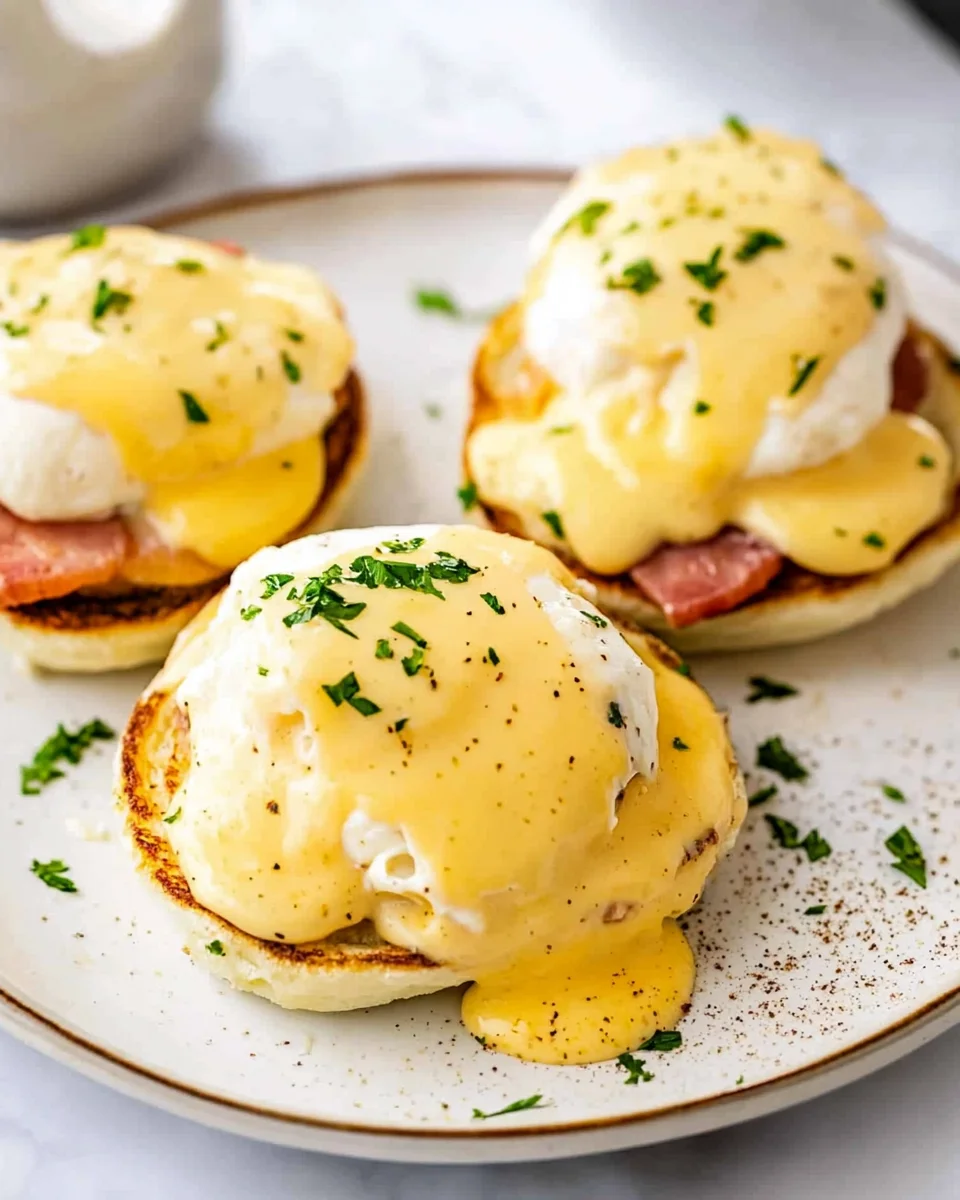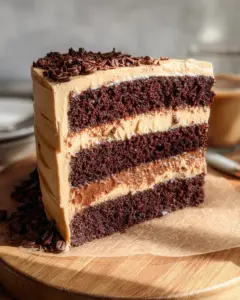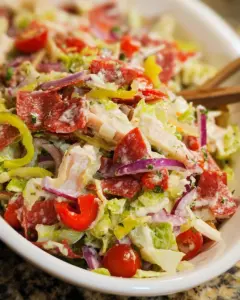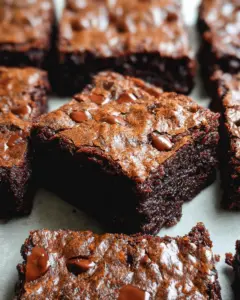Eggs Benedict is a beloved brunch dish that effortlessly combines rich flavors and textures. With its buttery toasted English muffins, crispy back bacon, perfectly poached eggs, and velvety hollandaise sauce, this dish not only satisfies your cravings but also elevates any occasion. Whether it’s a weekend treat or a special celebration, Eggs Benedict is sure to impress.

Jump to:
- Why You’ll Love This Recipe
- Tools and Preparation
- Essential Tools and Equipment
- Importance of Each Tool
- Ingredients
- For the Poached Eggs:
- For the Eggs Benedict:
- How to Make Eggs Benedict
- Step 1: Poach the Eggs
- Step 2: Prepare the Eggs Benedict
- How to Serve Eggs Benedict
- Classic Presentation
- Pair with Fresh Ingredients
- Elevate with Unique Variations
- How to Perfect Eggs Benedict
- Best Side Dishes for Eggs Benedict
- Common Mistakes to Avoid
- Storage & Reheating Instructions
- Refrigerator Storage
- Freezing Eggs Benedict
- Reheating Eggs Benedict
- Frequently Asked Questions
- What is Eggs Benedict?
- How do I make hollandaise sauce for Eggs Benedict?
- Can I customize my Eggs Benedict?
- How long does it take to prepare Eggs Benedict?
- Can I use other types of bread instead of English muffins?
- Final Thoughts
- 📖 Recipe Card
Why You’ll Love This Recipe
- Deliciously Indulgent: The combination of savory bacon and creamy hollandaise creates an irresistible flavor profile.
- Perfect for Any Occasion: Whether you’re hosting brunch or enjoying a quiet breakfast at home, this dish fits the bill.
- Easy to Customize: You can easily swap ingredients like avocado or smoked salmon for a unique twist on the classic recipe.
- Impressive Presentation: The layers of ingredients make for a visually appealing dish that looks as good as it tastes.
- Satisfying Meal: Packed with protein and flavor, Eggs Benedict will keep you full for hours.
Tools and Preparation
To make the perfect Eggs Benedict, having the right tools is essential. Here’s what you’ll need to set yourself up for success.
Essential Tools and Equipment
- Pot for boiling water
- Slotted spoon
- Skillet
- Baking sheet
- Ramekins
- Whisk (for hollandaise sauce)
Importance of Each Tool
- Pot for boiling water: A deep pot helps maintain temperature while poaching eggs evenly.
- Slotted spoon: This tool allows you to lift poached eggs without breaking them.
- Skillet: Ideal for cooking bacon quickly and evenly without excess grease.
- Baking sheet: Perfect for broiling English muffins to achieve the desired crispiness.
Ingredients
For the Poached Eggs:
- 8 large eggs
- 1 tablespoon white vinegar
For the Eggs Benedict:
- 8 slices back bacon (Canadian bacon)
- 4 English muffins, halved
- ¼ cup butter, softened
- 1 cup hollandaise sauce
- 1 tablespoon chives, finely chopped (for garnish)

How to Make Eggs Benedict
Step 1: Poach the Eggs
- Bring a pot of water to a boil. Add the vinegar and reduce heat to a gentle simmer.
- Crack an egg into a small ramekin. Gently drop it into the water. Repeat with three more eggs.
- Turn off the heat and cover the pot. Let the eggs cook in hot water for about 4 minutes or until whites are set with runny yolks.
- Use a slotted spoon to remove eggs and place them on a paper towel-lined plate. Repeat with remaining eggs.
Step 2: Prepare the Eggs Benedict
- Heat a skillet over medium-high heat. Add back bacon slices; cook for 1-2 minutes per side until browned. Set aside.
- Preheat your oven’s broiler. Spread butter on each English muffin half; place cut side up on a baking sheet.
- Broil for 1-3 minutes until golden brown.
- To assemble, place a slice of back bacon on each toasted muffin half. Carefully add a poached egg on top and spoon hollandaise sauce over each egg.
- Garnish with chives before serving.
Now you’re ready to enjoy this delightful dish! Whether you serve it at brunch or breakfast, your guests will be asking for seconds!
How to Serve Eggs Benedict
Serving Eggs Benedict is all about presentation and enhancing the flavors. This dish not only looks delightful but also tastes fantastic when paired with complementary sides and garnishes.
Classic Presentation
- Garnish with Chives: Finely chopped chives add a fresh, mild onion flavor that enhances the dish.
- Serve on a Warm Plate: Keep the dish warm by pre-heating your plates; this helps maintain the temperature of the poached eggs.
Pair with Fresh Ingredients
- Add Avocado Slices: Creamy avocado slices can provide a rich texture and additional nutrients.
- Include Fresh Tomato: A slice of juicy tomato adds freshness and color to the plate.
Elevate with Unique Variations
- Try Smoked Salmon: For a gourmet twist, substitute back bacon with smoked salmon for a delicious seafood flavor.
- Use Spinach or Arugula: Adding a handful of sautéed spinach or arugula under the egg can give a nice contrast in flavors.
How to Perfect Eggs Benedict
Perfecting Eggs Benedict requires attention to detail, especially with poaching the eggs and preparing hollandaise sauce. Follow these tips for an outstanding brunch experience.
- Bold Timing: Pay close attention to cooking times for poached eggs; 4 minutes yields a soft yolk, while longer cooking results in firmer yolks.
- Bold Vinegar Usage: Adding vinegar to the poaching water helps set the egg whites quickly, preventing them from spreading out too much.
- Bold Hollandaise Technique: Whisk your hollandaise sauce continuously over low heat to prevent it from curdling while ensuring it remains smooth and creamy.
- Bold Muffin Toasting: Broil the English muffins just until golden; they should be crispy enough to hold up under the toppings without getting soggy.
- Bold Bacon Crispiness: Cook the back bacon until it’s nicely browned for added flavor and texture that complements the dish perfectly.

Best Side Dishes for Eggs Benedict
A well-rounded meal is essential when serving Eggs Benedict. These side dishes can enhance your brunch experience and provide variety.
- Mixed Green Salad: A light salad adds freshness; consider using a vinaigrette for acidity that cuts through richness.
- Fruit Salad: Seasonal fruits can balance the flavors of Eggs Benedict; opt for berries or citrus fruits for brightness.
- Hash Browns: Crispy hash browns offer a satisfying crunch that pairs well with soft poached eggs.
- Sautéed Asparagus: Lightly sautéed asparagus provides a healthy green option that complements the richness of hollandaise sauce.
- Roasted Potatoes: Seasoned roasted potatoes add heartiness and are perfect for soaking up extra hollandaise sauce.
- Grilled Tomatoes: Grilled tomatoes bring natural sweetness and acidity, pairing beautifully with savory elements of Eggs Benedict.
Common Mistakes to Avoid
Making Eggs Benedict can be a rewarding experience, but there are common mistakes that can affect the final result. Here are some tips to help you avoid pitfalls and enjoy a perfect dish.
- Overcooking the Eggs: If you cook the eggs for too long, the yolks will harden. Aim for 4 minutes for soft poached eggs.
- Neglecting the Sauce: A bland hollandaise sauce can ruin your dish. Use fresh ingredients and whisk thoroughly for the best flavor.
- Skipping the Vinegar: Vinegar helps coagulate the egg whites. Don’t forget to add it to the simmering water for perfect poached eggs.
- Using Stale Muffins: Fresh English muffins make a big difference. Always use fresh ones and toast them until golden brown for crunch.
- Not Prepping Ahead: Timing is crucial. Prepare your hollandaise sauce in advance and keep it warm while you cook everything else.
Storage & Reheating Instructions
Refrigerator Storage
- Store leftover Eggs Benedict in an airtight container in the fridge.
- They will last up to 2 days, but they are best eaten fresh.
Freezing Eggs Benedict
- It is not recommended to freeze assembled Eggs Benedict, as the texture of eggs and sauce may change.
- You can freeze components separately, like cooked back bacon and hollandaise, for up to 1 month.
Reheating Eggs Benedict
- Oven: Preheat to 350°F (175°C). Place assembled muffins on a baking sheet and warm for about 10 minutes.
- Microwave: Heat on medium power in short bursts of 30 seconds until warmed through; this method may affect texture.
- Stovetop: Reheat components separately over low heat, ensuring eggs don’t overcook again.

Frequently Asked Questions
What is Eggs Benedict?
Eggs Benedict is a classic brunch dish that features poached eggs on toasted English muffins with back bacon and hollandaise sauce.
How do I make hollandaise sauce for Eggs Benedict?
To make hollandaise sauce, whisk together egg yolks, lemon juice, and melted butter until thickened. Season with salt and pepper.
Can I customize my Eggs Benedict?
Absolutely! You can swap out back bacon for smoked salmon or sautéed spinach for a different twist on this classic dish.
How long does it take to prepare Eggs Benedict?
The total time to prepare Eggs Benedict is about 30 minutes, which includes both prep and cooking time.
Can I use other types of bread instead of English muffins?
Yes, you can use other breads like bagels or croissants if you prefer a different base for your Eggs Benedict.
Final Thoughts
Eggs Benedict is not just a meal; it’s an experience! This dish’s combination of flavors makes it perfect for brunches or special occasions. Feel free to explore different toppings or sauces to customize your version. Give this classic recipe a try—you won’t be disappointed!
Did You Enjoy Making This Recipe? Please rate this recipe with ⭐⭐⭐⭐⭐ or leave a comment.
📖 Recipe Card
Print
Eggs Benedict
- Total Time: 30 minutes
- Yield: Serves 4
Description
Eggs Benedict is the epitome of brunch indulgence, featuring buttery toasted English muffins topped with crispy Canadian bacon, perfectly poached eggs, and a luxurious hollandaise sauce. This classic dish not only satisfies your cravings but also impresses at any gathering. With its rich flavors and elegant presentation, Eggs Benedict transforms a regular breakfast into a gourmet experience. Whether you’re hosting friends or enjoying a quiet morning at home, this recipe is sure to elevate your meal. Plus, it’s easily customizable—swap in smoked salmon or sautéed spinach for delightful variations!
Ingredients
- 8 large eggs
- 1 tablespoon white vinegar
- 8 slices back bacon (Canadian bacon)
- 4 English muffins, halved
- ¼ cup butter, softened
- 1 cup hollandaise sauce
- 1 tablespoon chives, finely chopped (for garnish)
Instructions
- Poach the eggs by boiling water with vinegar, simmering gently, and cooking each egg for about 4 minutes until whites are set.
- Sauté back bacon in a skillet until browned.
- Broil English muffin halves spread with butter until golden.
- Assemble by placing bacon on each muffin half, adding a poached egg on top, and drizzling with hollandaise sauce.
- Garnish with chives before serving.
- Prep Time: 15 minutes
- Cook Time: 15 minutes
- Category: Main
- Method: Poaching/Sautéing/Broiling
- Cuisine: American
Nutrition
- Serving Size: 1 serving
- Calories: 400
- Sugar: 1g
- Sodium: 800mg
- Fat: 30g
- Saturated Fat: 10g
- Unsaturated Fat: 15g
- Trans Fat: 0g
- Carbohydrates: 30g
- Fiber: 2g
- Protein: 12g
- Cholesterol: 250mg





